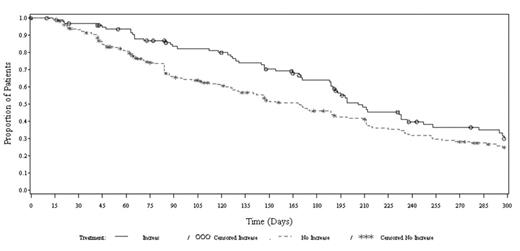Abstract
Myeloma bone disease is characterized by osteolytic destruction associated with suppressed osteoblastic activity possibly through inhibition of the WNT signaling pathway. We already reported the association between increased alkaline phosphatase (ALP) and B but not dexamethasone response in myeloma patients (Zangari et al., BJH 2005, in press). To extend these observations, using data from the large APEX study, we have attempted to assess the relationship between quantitative alkaline phosphatase (ALP) changes during therapy with B and response and time to progression. We were interested in what threshold of increase in ALP (even within the normal laboratory range) might predict efficacy.
Methods: A group of patients with no biochemical evidence of liver disease and creatinine clearances > 50 mL/minute treated with bortezomib 1.3 mg/m2 on days 1, 4, 8 and 11 for up to eight 3-week cycles followed by bortezomib 1.3 mg/m2 on days 1, 8, 15 and 22 for up to three 5-week cycles were studied. The percentage increase of ALP levels in responders and non-responders was analyzed at different thresholds and time points after baseline. Responses (the sum of CR plus PR) were based on EBMT criteria. The change from baseline ALP during therapy with B was compared in responders and non-responders.
Results: There were 229 patients with a median age of 60 years. 59% were male; median B2M was 3.2 mg/L, myeloma subtypes included IgG 64%, IgA 24%; median time from diagnosis was 41 months. The median ALP elevation from baseline for bortezomib responding patients was approximately 25% but even a 10% ALP increment at week 6 from baseline was strongly associated with response (P=0.0001). The most powerful predictor of response was a 25% ALP elevation at week 6.
| Parameter . | 25% ALP Elevation . | <25% ALP Elevation . | p-value . |
|---|---|---|---|
| N | 64 | 154 | |
| CR n (%) | 10 (16) | 12 (8) | 0.0966 |
| PR n (%) | 35 (55) | 42 (27) | <0.0001 |
| CR/PR n (%) | 45 (70) | 54 (35) | <0.0001 |
| Parameter . | 25% ALP Elevation . | <25% ALP Elevation . | p-value . |
|---|---|---|---|
| N | 64 | 154 | |
| CR n (%) | 10 (16) | 12 (8) | 0.0966 |
| PR n (%) | 35 (55) | 42 (27) | <0.0001 |
| CR/PR n (%) | 45 (70) | 54 (35) | <0.0001 |
Cox regression analysis showed that ALP elevation of 25% was not only associated with response rate but was also positively correlated with time to progression (P=0.0022).
For all bortezomib treated patients enrolled in the trial (n=333) regardless of their baseline (LFTs and creatinine), a 25% increase in ALP from the baseline to 6 week remained strongly associated with a very high response rate (p<0.0001) and longer time to progression (206 vs 169 days) p=0.01.
At the time of relapse after B therapy, the median ALP was 65.0 U/L and comparable to baseline level (65.5 U/L).
Conclusion:
During bortezomib treatment, markers of osteoblastic activation (such as ALP) may predict response and response duration in patients with multiple myeloma. In addition, this suggests that bone anabolism could affect myeloma growth. This observation needs to be confirmed prospectively.
Author notes
Corresponding author


This feature is available to Subscribers Only
Sign In or Create an Account Close Modal